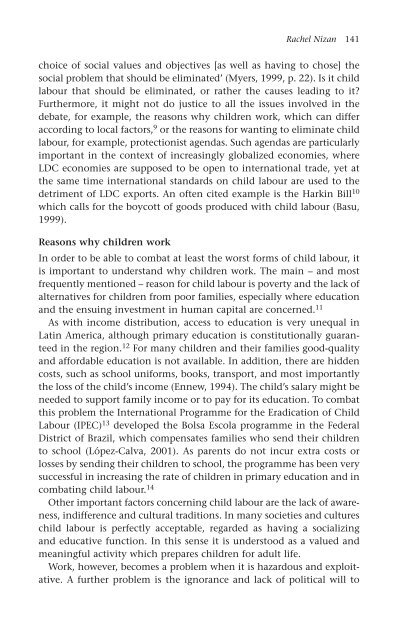3071-The political economy of new slavery
3071-The political economy of new slavery
3071-The political economy of new slavery
Create successful ePaper yourself
Turn your PDF publications into a flip-book with our unique Google optimized e-Paper software.
Rachel Nizan 141<br />
choice <strong>of</strong> social values and objectives [as well as having to chose] the<br />
social problem that should be eliminated’ (Myers, 1999, p. 22). Is it child<br />
labour that should be eliminated, or rather the causes leading to it?<br />
Furthermore, it might not do justice to all the issues involved in the<br />
debate, for example, the reasons why children work, which can differ<br />
according to local factors, 9 or the reasons for wanting to eliminate child<br />
labour, for example, protectionist agendas. Such agendas are particularly<br />
important in the context <strong>of</strong> increasingly globalized economies, where<br />
LDC economies are supposed to be open to international trade, yet at<br />
the same time international standards on child labour are used to the<br />
detriment <strong>of</strong> LDC exports. An <strong>of</strong>ten cited example is the Harkin Bill 10<br />
which calls for the boycott <strong>of</strong> goods produced with child labour (Basu,<br />
1999).<br />
Reasons why children work<br />
In order to be able to combat at least the worst forms <strong>of</strong> child labour, it<br />
is important to understand why children work. <strong>The</strong> main – and most<br />
frequently mentioned – reason for child labour is poverty and the lack <strong>of</strong><br />
alternatives for children from poor families, especially where education<br />
and the ensuing investment in human capital are concerned. 11<br />
As with income distribution, access to education is very unequal in<br />
Latin America, although primary education is constitutionally guaranteed<br />
in the region. 12 For many children and their families good-quality<br />
and affordable education is not available. In addition, there are hidden<br />
costs, such as school uniforms, books, transport, and most importantly<br />
the loss <strong>of</strong> the child’s income (En<strong>new</strong>, 1994). <strong>The</strong> child’s salary might be<br />
needed to support family income or to pay for its education. To combat<br />
this problem the International Programme for the Eradication <strong>of</strong> Child<br />
Labour (IPEC) 13 developed the Bolsa Escola programme in the Federal<br />
District <strong>of</strong> Brazil, which compensates families who send their children<br />
to school (López-Calva, 2001). As parents do not incur extra costs or<br />
losses by sending their children to school, the programme has been very<br />
successful in increasing the rate <strong>of</strong> children in primary education and in<br />
combating child labour. 14<br />
Other important factors concerning child labour are the lack <strong>of</strong> awareness,<br />
indifference and cultural traditions. In many societies and cultures<br />
child labour is perfectly acceptable, regarded as having a socializing<br />
and educative function. In this sense it is understood as a valued and<br />
meaningful activity which prepares children for adult life.<br />
Work, however, becomes a problem when it is hazardous and exploitative.<br />
A further problem is the ignorance and lack <strong>of</strong> <strong>political</strong> will to


